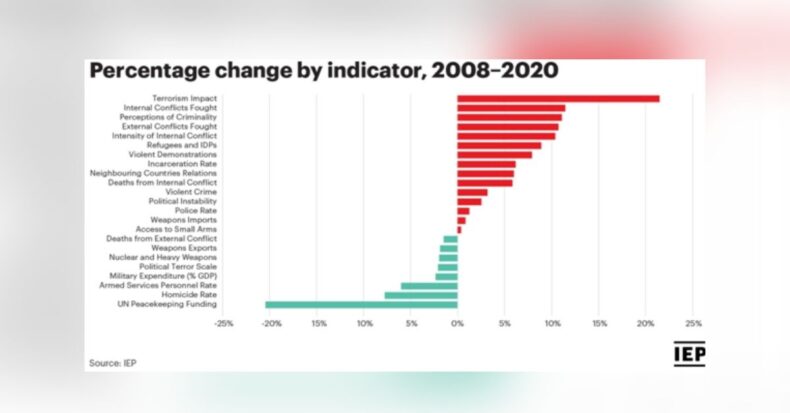Drawing a parallel between the ranks of India in the global Peace and safety indexes with some of the most dangerous countries in the world.
We frequently read about gory and horrifying cases of crimes around the country on our mobile screens. Social media has especially gained ground on spreading thought-provoking subjects and specifying ways the general population can get involved and help out.
Most often than not, these graphic headlines become a cause of sadness and faltering faith in humanity for a wink before we trudge along with our daily routines. Location-specific feeds on our Instagram and Twitter each day bring out human brutalities in short-form content.
We remain familiar with the news across Indian states and few significant ones from foreign countries.
But what are the inferences from India’s ranks compared to the most dangerous countries in the world?
To answer this, we need first to understand the factors behind deciding the threat of criminality worldwide.
The Institute of Economics and Peace releases its one-of-a-kind ‘Peace Index’ every year. This index measures the level of safety in 163 countries, accounting for 99% of the population, based on 23 indicators of Peace.
The general schedule of the Index is to capture the qualitative and quantitative rating of ongoing domestic and international conflict, societal safety and security, and militarization of the inspected countries.
In the Global Peace Index of 2021, India climbed up two notches from the past year to become the 135th most peaceful country globally. This status might mean significantly less than the most peaceful countries like Iceland, Denmark, New Zealand, Portugal and Slovenia. Still, it’s streets ahead when it comes to the most dangerous countries.
The bottom five rungs of the Index are taken up by Afghanistan (deemed the most dangerous country in the world on all accounts), followed upward by Yemen, Syria, South Sudan, and Iraq.
How does India compare to the Threat levels in the most unsafe countries?
India was part of a comparatively more minor conflict with its neighbouring country Pakistan over the insurgency in J&K, with 750 fatalities in 2020 and 440 in 2021.
The internal conflicts related to Left Wing Extremism were prevalent but declining in 25 most affected districts and 70 total affected communities in 2021, including Chhattisgarh, Bihar, Jharkhand, Orissa and West Bengal.
Ethnic conflicts and separatist movements in Northeast regions of Nagaland, Manipur, and Assam also cause political tensions with a handful of fatalities. Internationally, border tensions with China remain at a simmering. The general population in India, unlike the most dangerous countries, remains comparatively protected.
The Islamic- state Taliban conflict and anti-Taliban conflict, along with the Yemen crisis and the Ethiopian- Sudanese clashes, are significant wars with hundreds and thousands of deaths in 2021 alone that make Afghanistan, Yemen and South Sudan some of the worst places to be on the planet right now.
Syria and Iraq were majorly affected due to the ISIS threat and violation, with 11.1 million people in need of humanitarian aid due to its direct impact in Syria alone.
Terrorism in India is ranked 7.35 on a scale of 0 to 10 on the Global Terrorism Index, while Yemen is 7.58, Iraq is 8.68, and Afghanistan takes the highest spot with a score of 9.59 with its current Taliban crisis.
Societal Safety and Security is measured and classified based on various factors: private Security, cyber security, fire safety and detection, etc. India ranks significantly low at 76th place among 82 economies due to its mammoth lack of social Security and fair wage distribution according to the social mobility index compiled by the world economic forum.
Afghanistan has been ranked as the least peaceful nation on the planet with the lowest rank on societal safety and Security.
According to the Women Peace and Security Index, India ranked 133 out of 167 countries in terms of women’s safety in 2019. 18% of women aged 18-49 have been physically abused in India. Assam reported the highest rates of crimes against women, with around 154.3 crimes reported for every 100,000 women, closely followed by Delhi, with a crime rate of 106.4
Now under the Taliban’s oppressive regime Afghanistan ranks the lowest on Women safety indexes. Women are not free to even walk around in the country, with everything from their attire to their education and work dictated by a governing body that hardly represents them.
Although India is not the worst-ranked country in terms of all the Index indicators, it is still one of the most unsafe places for women and minorities.
The general population, which is considerable, bumps up the country’s average level of Peace and security ranks.
While being comparatively much safer than the war-infested territories mentioned above, India still desperately needs a more substantial social and political reform and security net to promote true well-being and equity among its people.













